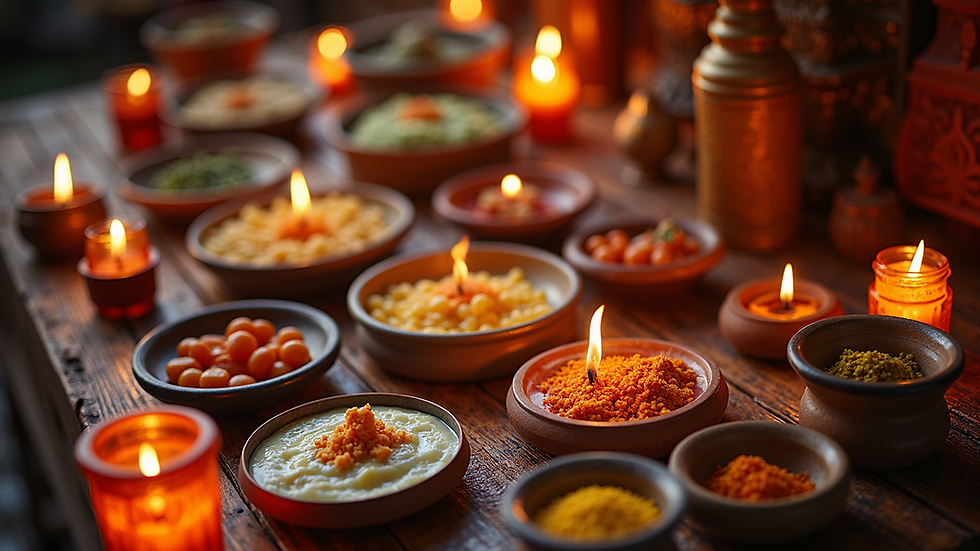The Design Philosophy Behind It All
- Anjali Agrawal

- Aug 4
- 4 min read
In the realm of design, there is a powerful philosophy that goes beyond simply making attractive objects. This viewpoint highlights the stories and experiences that shape our interactions with each item in our lives. From the rituals involving puja essentials to the careful arrangement of pantry items, our design philosophy is grounded in understanding how these pieces fit into our daily routines. Each silk saree and travel souvenir holds a memory, and as designers, our goal is to simplify and clarify the relationships between people and their possessions.
Design is about more than creating beautiful spaces. It's about fostering clarity, ease, and organization, helping you live your life without the frustration of misplaced items.
The Essence of Purpose-Driven Design
Understanding design means recognizing that it is not solely about appearances; it is about the purpose of each design element. The blend of functionality and form is critical to ensuring that every choice made truly meets the user’s needs. For example, when designing storage for puja essentials, it is vital to consider not only where each item will go but also the significance of the rituals they support.
Research has shown that a cluttered environment can lead to increased stress and difficulty concentrating. In fact, a study found that 75% of people feel overwhelmed by their clutter. By thoughtfully designing spaces, we can contribute to a person’s well-being. When everything is organized, it allows for greater focus on meaningful tasks, ultimately leading to a more centered life.

Spaces that Empower
Being mindful of the emotions and memories we associate with our belongings is crucial in design. Take travel keepsakes, for instance. Instead of throwing them into a drawer, consider creating a display that both stores and celebrates these memories. A shadow box filled with mementos from a Europe trip can be a stunning piece of decor and a reminder of your adventures.
Well-designed spaces empower individuals by developing systems that align with their routines. Picture a pantry stocked with ingredients, where every item is labeled and within reach. This organization transforms cooking from a chore into an enjoyable activity. According to studies, individuals who enjoy cooking report feeling happier and less stressed. This is the kind of lifestyle design aims to promote.
The Importance of Clarity in Design
At its core, design is about clarity. When a space is well planned, navigating it becomes second nature. Imagine stepping into a kitchen where each tool has a dedicated space, and the layout flows logically. This approach goes beyond just how things look; it’s about creating environments that enhance everyday living.
Many struggle with chaotic spaces that contribute to feelings of overwhelm. Research by the National Association of Professional Organizers indicates that 80% of people feel stressed by their living environments. By emphasizing design principles that prioritize clarity, we can alleviate this stress. Logical layouts and clear visual cues facilitate smoother daily activities, allowing for a serene experience that encourages engagement and mindfulness.

Ease of Access and Interaction
Making design intuitive is key to enhancing daily interactions. This means placing furniture in a way that promotes natural movement throughout a space. For example, envision a living room set up for family gatherings, where couches encourage conversation, coffee tables have ample space for snacks, and shelves hold books and games for easy access.
Every design element works together to create a welcoming atmosphere that highlights how design ties into relationships, shaping the way people engage with each other and their surroundings.
Real-Life Applications
Real-life examples of this philosophy in action illustrate its effectiveness. When redesigning a workspace or a children's play area, using flexible storage solutions can have a significant impact. For instance, modular furniture that can be reconfigured as needs change provides both adaptability and style.
If a storage solution is attractive, people are more likely to use it effectively. Consider a beautifully designed storage bench that serves as seating while keeping toys or supplies organized. This thoughtful approach transforms chaos into calm, creating a more pleasant environment.
A Touchstone for Design Decisions
This philosophy serves as a guiding principle for every design decision we make. When approaching a project, we consistently ask ourselves: How can we enhance clarity? How can we ease daily life? As designers, we focus on timeless principles rather than fleeting trends, ensuring we create solutions that improve users’ quality of life.
By exploring the reasoning behind each design choice, we challenge ourselves to create meaningful solutions that meet human needs. This approach ensures that the final outcome is not only visually appealing but also a genuine enhancement to people’s lives.
Reflecting on Our Design Philosophy
Our philosophy emphasizes that we do not design for objects but for the stories and lives connected to them. From puja essentials to pantry staples, each item serves a purpose that stretches beyond simple functionality. By concentrating on clarity, ease, and logical interaction, we create spaces that are not only beautiful but enriching to live in.
By nurturing the life behind every object, we seek to minimize everyday friction and deepen our connection with the world around us. After all, a well-designed space invites us to be present, value our relationships, and navigate our days with confidence, allowing us to never wonder, “Where did I put that?”
Design is more than just arranging space; it reflects life's complexities, our shared experiences, and the foundation for lasting happiness and connection.



Comments